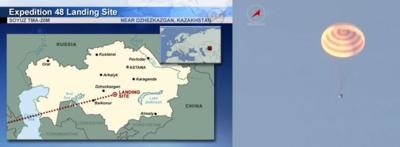Expedition 48 Commander Jeff Williams Has Logged 534 Days In Space
NASA astronaut and Expedition 48 Commander Jeff Williams returned to Earth Tuesday after his U.S. record-breaking mission aboard the International Space Station.

Williams (pictured) and his Russian crewmates Alexey Ovchinin and Oleg Skripochka, of the Russian space agency Roscosmos, landed in their Soyuz TMA-20M at 9:13 p.m. EDT southeast of the remote town of Dzhezkazgan in Kazakhstan (7:13 a.m. Sept. 7, local time).
Having completed his fourth mission, Williams now has spent 534 days in space, making him first on the all-time NASA astronaut list. Skripochka now has 331 days in space on two flights, while Ovchinin spent 172 days in space on his first.
“No other U.S. astronaut has Jeff’s time and experience aboard the International Space Station. From his first flight in 2000, when the station was still under construction, to present day where the focus is science, technology development and fostering commercialization. Jeff even helped prepare the space station for future dockings of commercial spacecraft under NASA’s Commercial Crew Program,” said Kirk Shireman, ISS Program manager at NASA’s Johnson Space Center in Houston. “We’re incredibly proud of what Jeff has accomplished off the Earth for the Earth.”
Williams was instrumental in preparing the station for the future arrival of U.S. commercial crew spacecraft. The first International Docking Adapter was installed during a spacewalk by Williams and fellow NASA astronaut Kate Rubins Aug. 19. Outfitted with a host of sensors and systems, the adapter’s main purpose is to connect spacecraft bringing astronauts to the station in the future. Its first users are expected to be Boeing’s CST-100 Starliner and SpaceX’s Crew Dragon spacecraft, now in development in partnership with NASA.
During his time on the orbital complex, Williams ventured outside the confines of the space station for a second spacewalk with Rubins to retract a spare thermal control radiator and install two new high-definition cameras.

Together, the Expedition 48 crew members contributed to hundreds of experiments in biology, biotechnology, physical science and Earth science aboard humanity’s only orbiting laboratory.
The crew members also welcomed five cargo spacecraft during their stay. Williams was involved in the grapple of Orbital ATK’s Cygnus spacecraft in March, the company's fourth commercial resupply mission, and SpaceX’s eighth Dragon spacecraft cargo delivery in April, and welcomed a second Dragon delivery in July. Two Russian ISS Progress cargo craft also docked to the station in April and July delivering tons of supplies.
Expedition 49 continues operating the station with Anatoly Ivanishin of Roscosmos in command. He, Rubins, and Takuya Onishi of the Japan Aerospace Exploration Agency, will operate the station for more than two weeks until the arrival of three new crew members.
Shane Kimbrough of NASA and cosmonauts Sergey Ryzhikov and Andrey Borisenko of Roscosmos are scheduled to launch Sept. 23, U.S. time, from Baikonur, Kazakhstan.
(Images provided by NASA)
 ANN's Daily Aero-Linx (05.02.24)
ANN's Daily Aero-Linx (05.02.24) ANN's Daily Aero-Term (05.02.24): Touchdown Zone Lighting
ANN's Daily Aero-Term (05.02.24): Touchdown Zone Lighting Aero-News: Quote of the Day (05.02.24)
Aero-News: Quote of the Day (05.02.24) ANN FAQ: Contributing To Aero-TV
ANN FAQ: Contributing To Aero-TV NTSB Final Report: Cirrus Design Corp SR20
NTSB Final Report: Cirrus Design Corp SR20




